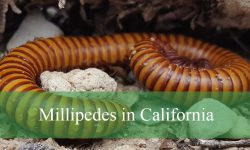North Carolina’s summer air is alive with the sound of cicadas, their steady hum echoing through forests, backyards, and meadows. These fascinating insects emerge in vast numbers or appear annually, filling warm days with their signature chorus. With dozens of species across the state, cicadas are an essential part of the region’s natural rhythm.
From the powerful calls of the Dog-day Cicada to the synchronized songs of the 17-year broods, each species has its own sound and story. Some thrive in pine forests near the coast, while others prefer the shaded hills of the Piedmont and mountains. Their diversity reflects North Carolina’s wide range of ecosystems.
This guide introduces 16 cicada species found throughout the state, complete with pictures and identification details. You’ll learn how to recognize each by its size, coloration, and song—and discover when and where to hear their mesmerizing voices during the heat of summer.
Common Cicadas Found in North Carolina
Dog-day Cicada (Neotibicen canicularis)
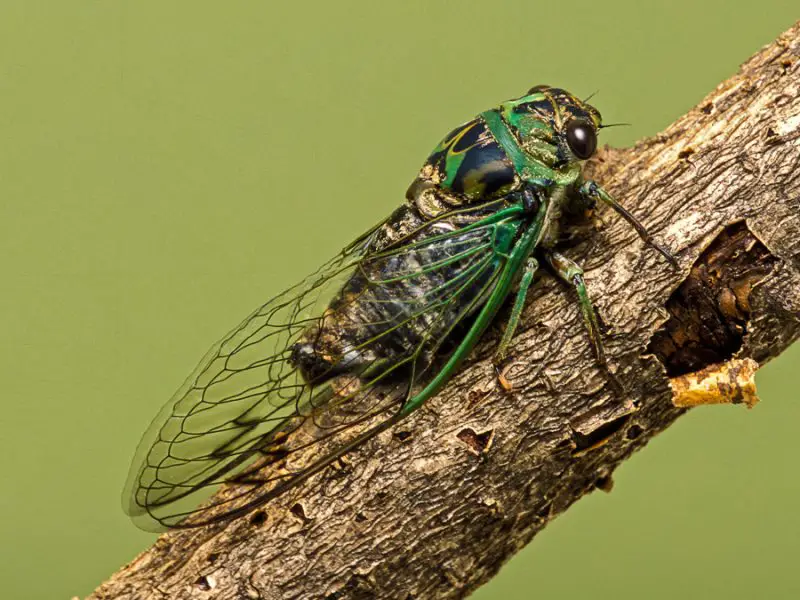
The Dog-day Cicada is one of the most recognizable summer insects in North Carolina, emerging during the hottest part of the season. Its body is stout and dark greenish-brown with a black thorax and pale green markings, blending well with tree bark. Adults typically measure about 1.5 inches long, with transparent wings that have a faint green tint and black veins near the base.
This species produces a distinct buzzing call that lasts for 15 to 20 seconds, often described as a steady, high-pitched whine resembling an electric buzz. Males sing from treetops during the late afternoon, using the sound to attract females and mark their territory. The call is loud and can be heard from several hundred feet away.
Dog-day Cicadas prefer deciduous forests, urban shade trees, and suburban neighborhoods with mature oaks, maples, or pines. They spend most of their lives underground as nymphs feeding on tree roots before emerging in mid to late summer. The adults are often seen clinging to tree trunks, power poles, or fences.
In North Carolina, this species is widespread across the Piedmont and mountain regions. They are especially common in rural and suburban areas where large trees provide ideal conditions for development and calling. Their appearance often signals the peak of summer heat and humidity in the state.
Eastern Scissors Grinder (Neotibicen winnemanna)

The Eastern Scissors Grinder is a medium to large cicada species with olive-green and brown coloration accented by dark markings on its thorax. It has broad, clear wings with greenish veins and a pale underside. Adults typically measure about 1.8 inches in length, making them slightly larger than most Dog-day Cicadas.
This cicada’s song is one of its defining traits—a long, steady “grinding” trill that rises and falls rhythmically, lasting up to a minute. The call often echoes through hardwood forests during the late afternoon and early evening. It sounds less harsh than that of other Neotibicen species, earning it the name “Scissors Grinder.”
Eastern Scissors Grinders inhabit mixed woodlands, riverbanks, and urban parks where tall deciduous trees are abundant. They are active from July through September, often emerging after heavy summer rains. Males perch on high branches while females move through the canopy to lay eggs in slender twigs.
In North Carolina, this species is common throughout the central and eastern regions, including the Piedmont and Coastal Plain. Their loud evening calls are a familiar sound in humid summer air, particularly in rural areas surrounded by forested landscapes.
Hieroglyphic Cicada (Neocicada hieroglyphica)
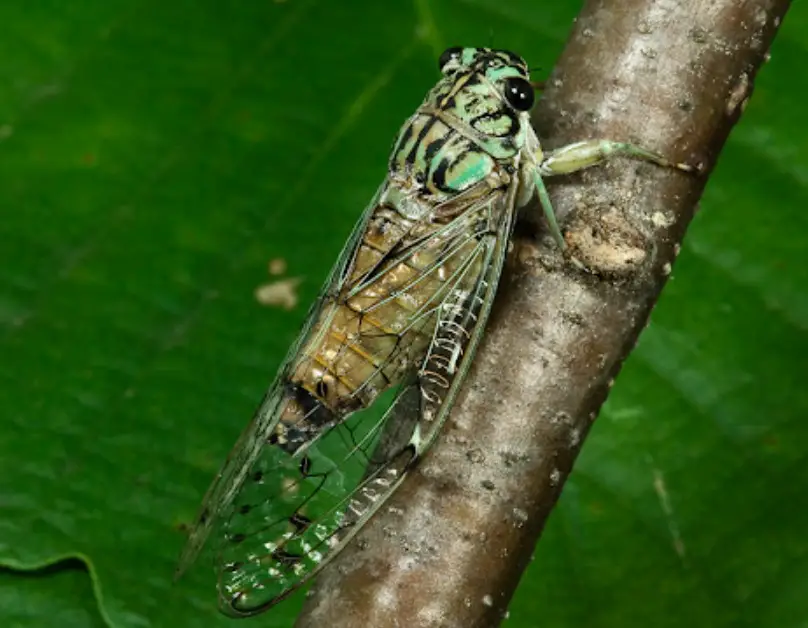
The Hieroglyphic Cicada is easily recognized by the striking black markings on its pale green thorax, which resemble ancient writing—hence its name. Its wings are clear with green veins, and the abdomen is dark brown to black. Adults are relatively small, measuring around 1 inch long, giving them a more compact appearance than most Neotibicen species.
This cicada produces a distinctive rattling buzz that starts abruptly and fades quickly, lasting only 10 to 15 seconds. The sound is sharp and metallic, often heard in short bursts from the upper branches of trees. Males sing during the daytime, usually from late morning to early afternoon.
Hieroglyphic Cicadas prefer sandy pine forests, scrublands, and dry oak ridges. They are often found along the Coastal Plain of North Carolina, where their preferred habitats are abundant. Their nymphs develop underground for several years, feeding on the sap of pine and oak roots before emerging in late spring.
In North Carolina, this species is most common in the southern and eastern parts of the state, including areas near Wilmington and Fayetteville. Their brief but loud calls contribute to the insect chorus that fills warm coastal days in midsummer.
Southern Grass Cicada (Cicadettana calliope)
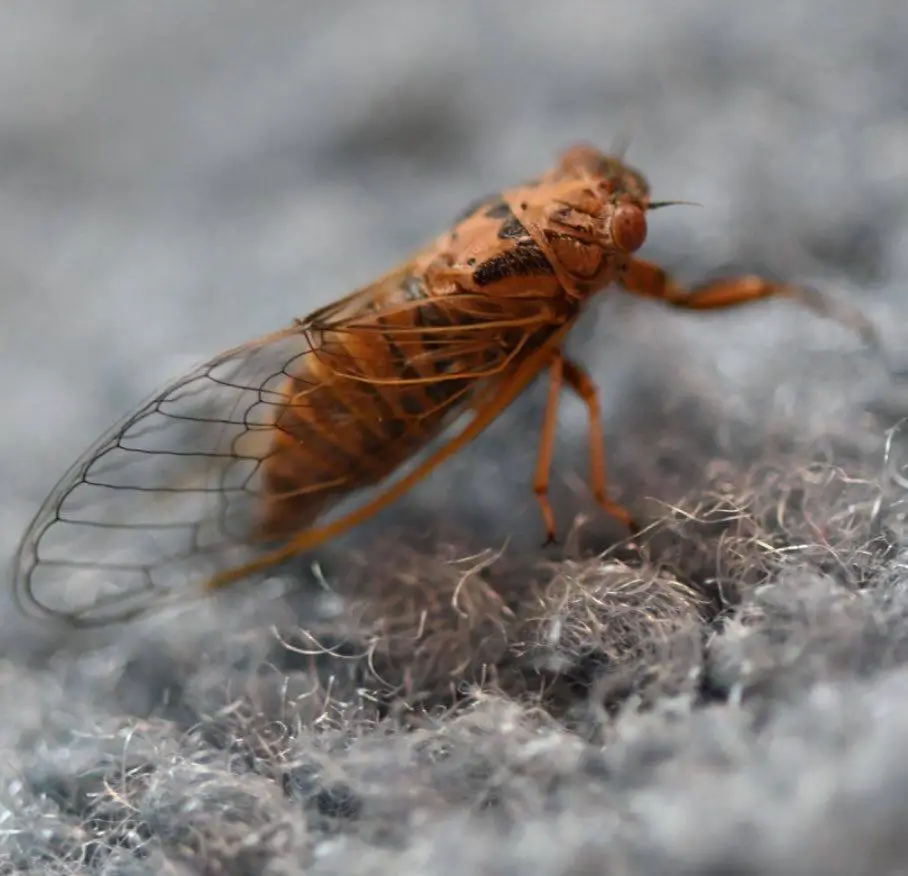
The Southern Grass Cicada is a smaller, more delicate species compared to the robust tree-dwelling cicadas. Its body is light brown or greenish-tan with subtle darker patterns and semi-transparent wings. Adults are about 0.8 to 1 inch in length, giving them a slender appearance suitable for their grassy environments.
Its song is a fast, high-pitched buzz lasting 5 to 10 seconds, often emitted in short bursts. Unlike the long droning calls of tree cicadas, the Southern Grass Cicada’s sound is crisp and localized, resembling the hum of small electrical machinery. Males sing from low vegetation, particularly during the late morning and early afternoon.
This species inhabits open fields, grasslands, and roadside edges, often where the soil is sandy or well-drained. They can also be found in grassy clearings within pine forests. Adults are active during the warm months of June through August, feeding on the sap of grasses and low shrubs.
In North Carolina, Cicadettana calliope is distributed mainly in the southern Coastal Plain and Sandhills regions. Their presence is more subtle than that of the larger forest cicadas, but their faint songs are an integral part of the summer soundscape in open meadows and prairies.
Olympic Scrub Cicada (Diceroprocta olympusa)
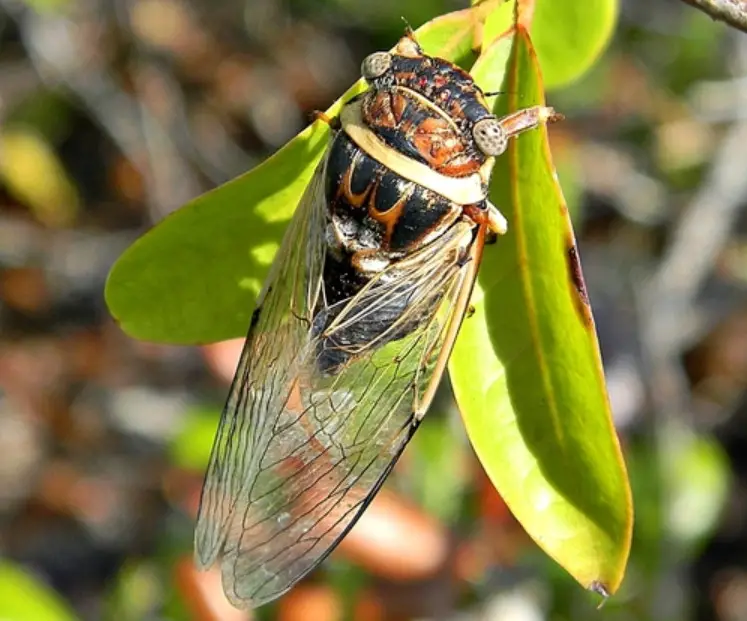
The Olympic Scrub Cicada is a small to medium-sized cicada characterized by a tan to light brown body with faint green markings on the thorax. Its wings are glassy and slightly iridescent, with pale veins that shimmer in sunlight. Adults average about 1 inch long, and their coloring helps them blend into sandy or rocky environments.
The call of this species is a rapid, vibrating buzz that rises and falls in short cycles, usually lasting 10 to 20 seconds. It is often described as a pulsating sound similar to a mechanical whirring noise. Males usually call during the hottest part of the day, especially in open, sun-exposed areas.
Olympic Scrub Cicadas prefer habitats such as dry pine woods, coastal dunes, and scrubby fields. They are well adapted to sandy soils where their nymphs feed on the roots of small shrubs and grasses. Adults emerge in midsummer and are active through early fall, often perching on low branches or even fence posts.
In North Carolina, this species is found mainly along the southern Coastal Plain, particularly near sandy coastal habitats and pine barrens. Their presence is more common in isolated patches of dry, open terrain, where their buzzing chorus resonates across the heat of midsummer afternoons.
Walker’s Cicada (Megatibicen pronotalis)
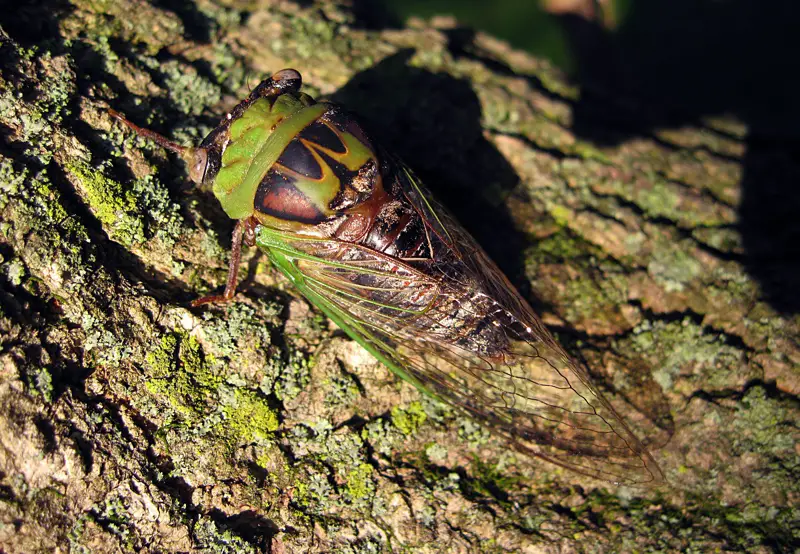
Walker’s Cicada is one of the largest cicada species found in North Carolina, known for its robust body and powerful song. Its coloration features a mix of olive green, brown, and black with a distinctly broad, dark band across the pronotum. Adults can measure up to 2 inches long, with wide, clear wings that extend well beyond the abdomen.
The sound produced by this species is deep, resonant, and pulsing—a continuous drone that can last up to a minute. It is one of the loudest cicadas in the region, often mistaken for an electrical hum from a distance. Males usually call during the afternoon and early evening, particularly on hot, sunny days.
Walker’s Cicadas prefer open woodlands, forest edges, and tall shade trees near rivers or wetlands. They are also found in suburban areas with mature trees. The nymphs spend several years underground feeding on the sap of tree roots before emerging in late July through September.
In North Carolina, this species is commonly encountered across the Piedmont and Coastal Plain regions. Their deep, rhythmic calls mark the height of summer, especially in areas with thick vegetation and abundant hardwoods.
Northern Dusk-Singing Cicada (Megatibicen auletes)
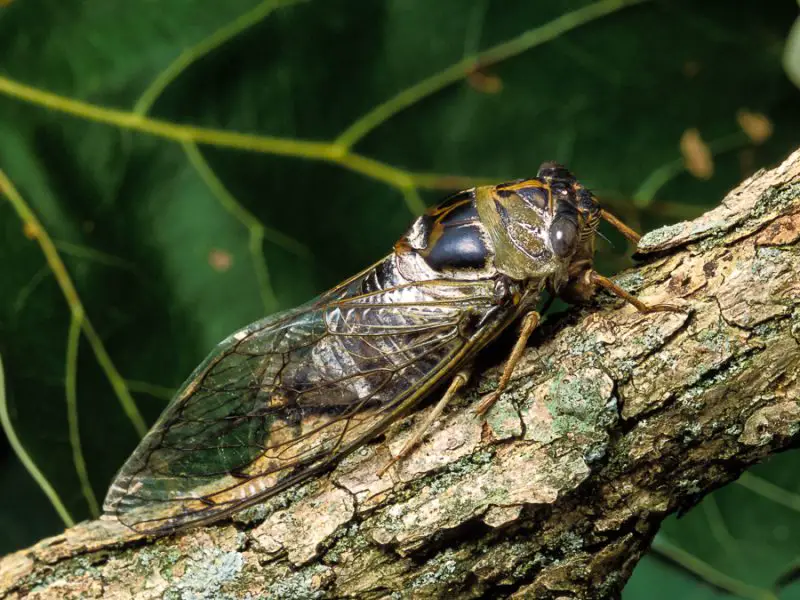
The Northern Dusk-Singing Cicada is another large and impressive cicada species native to North Carolina. It has a broad, heavy body with grayish-brown coloration and intricate green markings on the thorax. Adults measure up to 2.2 inches in length, making it the largest cicada in the eastern United States. Its wings are long and translucent, with greenish veins.
True to its name, this cicada sings during twilight, just before and after sunset. Its call is a deep, hollow, and throbbing buzz that echoes through forested areas. The sound rises in intensity, then fades, creating a haunting evening soundtrack across pine and oak woodlands.
This species thrives in sandy pine forests, coastal dunes, and mixed hardwood habitats. It prefers tall trees and undisturbed forest environments, where males perch high in the canopy to call. Adults appear from mid-July through September and are most active at dusk when few other cicadas are calling.
In North Carolina, the Northern Dusk-Singing Cicada is most common along the Coastal Plain and Sandhills regions. Its resonant twilight song is a distinctive feature of late-summer evenings in southern and eastern parts of the state.
Swamp Cicada (Neotibicen tibicen)
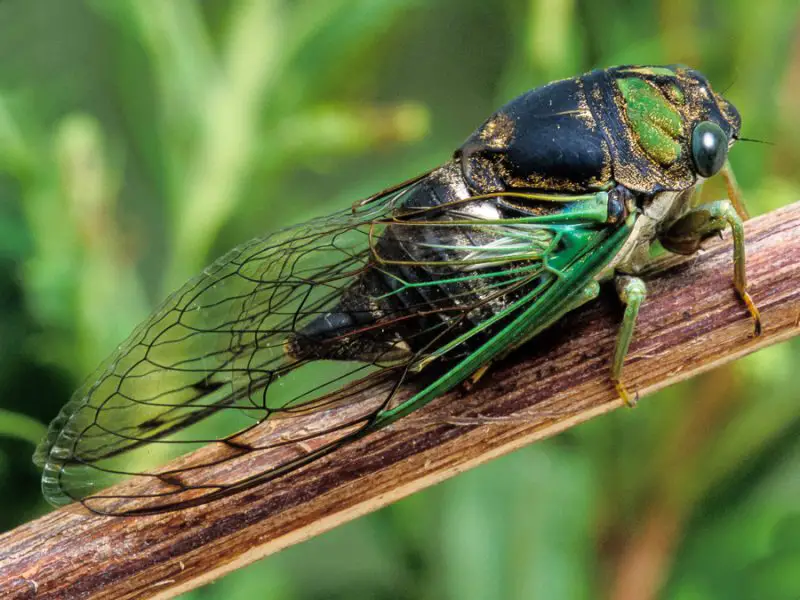
The Swamp Cicada is a medium to large cicada easily recognized by its glossy black body with bright green and white markings. The thorax has a bold green collar, and the wings are clear with greenish veins. Adults measure around 1.6 inches long and have a sleek, streamlined appearance that helps distinguish them from similar species.
Its call is a loud, whirring buzz that begins abruptly and gradually fades. The song lasts 20 to 30 seconds and is often compared to the sound of an electric fan or circular saw. Males sing during the heat of the day, especially from trees near moist or swampy areas.
This species prefers wet habitats such as riverbanks, swamps, and floodplains with tall trees. They are often found in low-lying hardwood forests, particularly near cypress or willow trees. Nymphs live underground for several years, feeding on roots before emerging in midsummer.
In North Carolina, the Swamp Cicada is widespread in both the Coastal Plain and lower Piedmont. Their droning calls often accompany the buzzing of insects in humid wetland forests during the peak of summer.
Scissor Grinder Cicada (Neotibicen pruinosus)
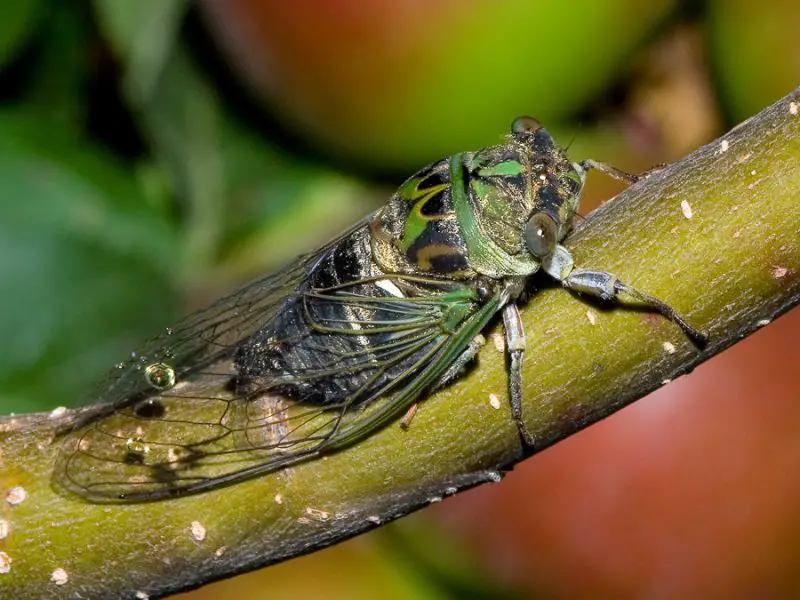
The Scissor Grinder Cicada is a medium-sized species with a green and black thorax, brownish abdomen, and frosty white patches on its sides. Adults typically measure about 1.5 inches long and have translucent wings with green veins. The species is named for its distinctive grinding call, which resembles the sound of a sharpening tool.
Its song is long and steady, lasting up to a minute, with a characteristic rising and falling tone. The sound is smoother and more musical than many other cicadas, making it one of the most recognizable summer noises across the region. Males sing from trees during the afternoon and early evening.
Scissor Grinder Cicadas are found in a variety of habitats, including woodlands, suburban neighborhoods, and rural fields lined with tall trees. They favor areas with oak, maple, or sycamore trees and thrive in both moist and dry conditions.
In North Carolina, this species is widespread throughout the Piedmont and western Coastal Plain. Their rhythmic, grinding songs fill the air from July through September, forming an essential part of the state’s late-summer soundscape.
Linne’s Cicada (Neotibicen linnei)

Linne’s Cicada is a medium-sized species known for its intricate green and black patterning and clear wings with pale green veins. The underside of the abdomen is whitish, often dusted with fine gray pruinosity. Adults measure about 1.4 inches long, giving them a slender yet sturdy appearance.
The call of Linne’s Cicada is a long, rising buzz that ends abruptly. The tone starts soft, builds in intensity, and stops suddenly, producing a pulsing rhythm. Males often sing from high perches during the day and at dusk, and their calls overlap with those of other Neotibicen species.
This species inhabits a range of environments, from city parks and suburban yards to deciduous forests and farmlands. It is highly adaptable and can thrive wherever mature trees are present. Adults appear from July through early September, especially during warm, sunny weather.
In North Carolina, Linne’s Cicada is widespread across the state, from the mountains to the coast. Its easily recognizable song and adaptability make it one of the most commonly encountered cicadas in both urban and natural settings.
17-year Cicada (Magicicada septendecim)
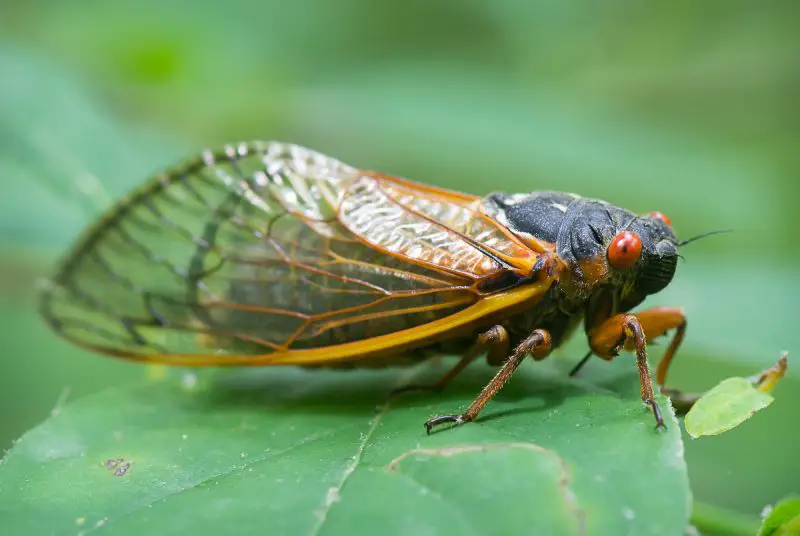
The 17-year Cicada (Magicicada septendecim) is one of the most well-known periodical cicadas in North Carolina, emerging in enormous numbers once every 17 years. It has a striking appearance—black body, red-orange eyes, and translucent wings with orange veins. Adults measure about 1 inch long, with broad heads and short antennae, giving them a somewhat compact form.
Its call is a loud, drawn-out “pharaoh” or “weeee-oooo” sound that rises and falls in a haunting rhythm. Males gather in chorus groups, their collective buzzing filling forests and neighborhoods alike. The sound can reach over 90 decibels in dense swarms, comparable to the hum of a lawnmower.
This species spends nearly its entire life underground as a nymph, feeding on tree root sap. After 17 years, they emerge synchronously in late spring, shed their nymphal skins, and take to the trees. Adults live for only four to six weeks, during which they mate and lay eggs in slender tree branches.
In North Carolina, Magicicada septendecim is mainly found in the western and Piedmont regions, particularly in forested and hilly areas. Their mass emergences are spectacular events that occur in May and June, filling the air with sound and activity after more than a decade of silence.
17-year Cicada (Magicicada cassini)
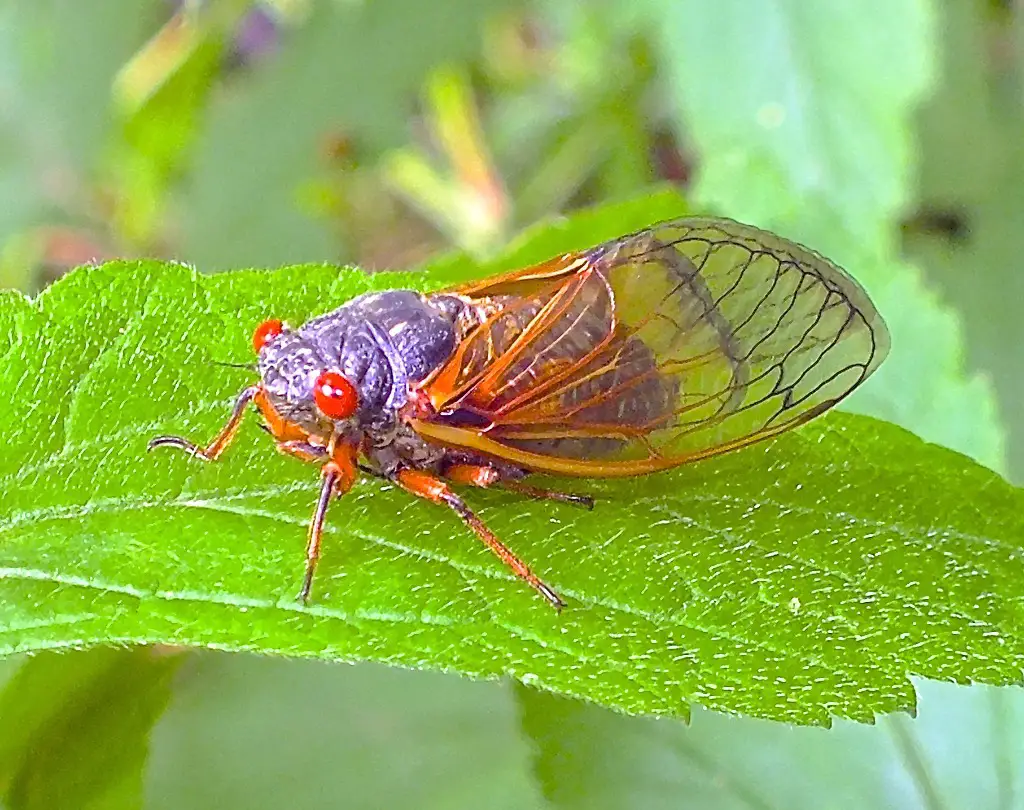
Magicicada cassini is a smaller 17-year cicada species that can be distinguished by its all-black abdomen without the orange bands seen in some other species. Adults measure around 0.9 to 1 inch long and have bright red eyes and clear wings with orange veins. Their compact size and glossy black coloration make them easy to identify during a brood emergence.
The call of Magicicada cassini is a rapid, high-pitched buzz that swells and fades rhythmically. When large groups sing together, the result is a pulsing roar that alternates between moments of near silence and intense sound. The males synchronize their calls, creating an echoing effect that fills forests with a mesmerizing chorus.
This species prefers deciduous forests, wooded suburbs, and areas with mature oaks and maples. Like other periodical cicadas, their nymphs live underground for 17 years before emerging simultaneously in late spring. Adults are active for about a month, during which mating and egg-laying dominate their short above-ground lives.
In North Carolina, Magicicada cassini occurs primarily in the mountain foothills and western Piedmont. During emergence years, they can be seen and heard in huge numbers, especially in rural and wooded communities where their songs blend into the summer heat.
17-year Cicada (Magicicada septendecula)
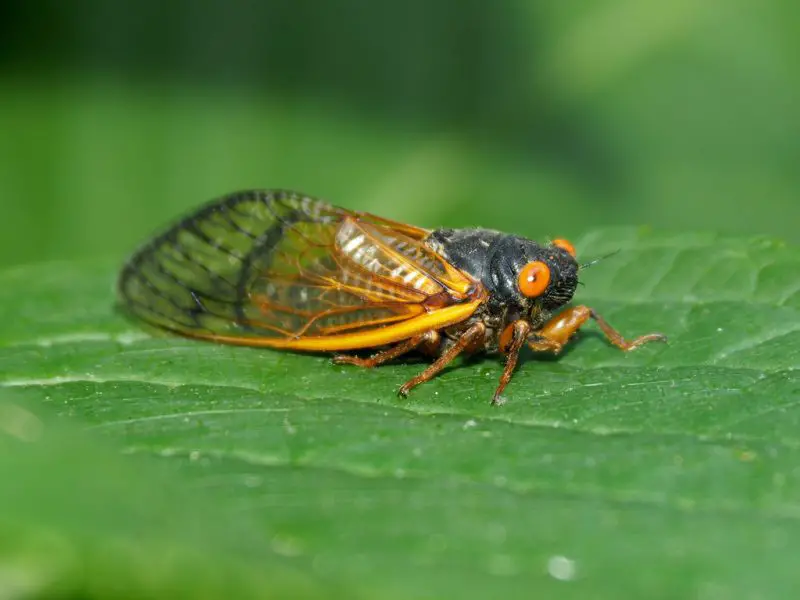
Magicicada septendecula is another member of the 17-year cicada group, slightly smaller and less common than its relatives. It features a black body, red eyes, and orange-veined wings, but the abdomen may show faint orange markings. Adults are about 0.9 inches long and tend to appear slightly later than other 17-year species during emergence events.
Its call is a steady, pulsing buzz that sounds like “zeee-zee-zee,” shorter and less musical than the song of Magicicada septendecim. Males call during the daytime from tree trunks or branches, and their collective noise creates a dense background hum in wooded areas.
This species typically inhabits mature deciduous forests, forest edges, and old-growth woodlands with abundant shade and moisture. Like all Magicicada species, it spends 17 years underground feeding on root fluids before emerging synchronously in massive numbers.
In North Carolina, Magicicada septendecula has been recorded mostly in the western counties, where it co-emerges with other 17-year species. Its presence adds variety to the chorus of sounds produced during these rare and fascinating natural events.
13-year Cicada (Magicicada tredecim)
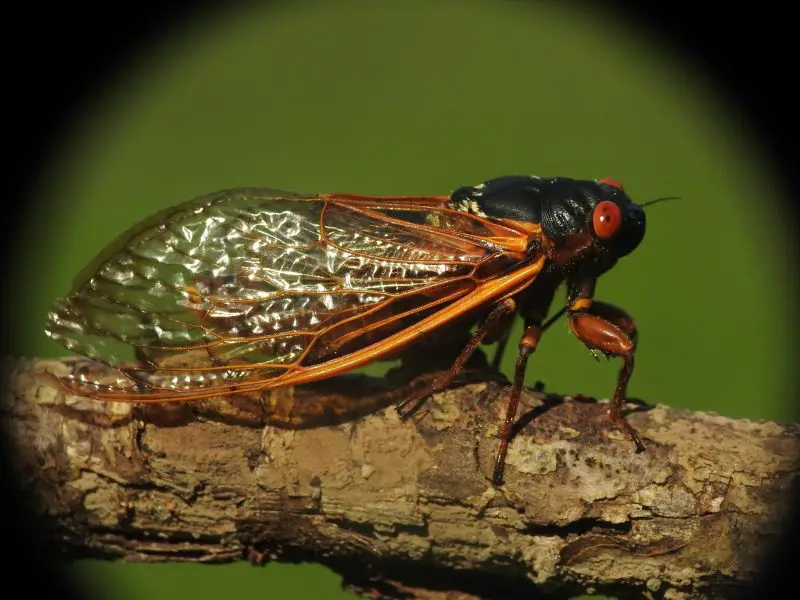
The 13-year Cicada (Magicicada tredecim) is one of the most widespread periodical cicadas in the southeastern United States. Adults are black with red-orange eyes and wing veins, but the abdomen shows broad orange bands, distinguishing them from the 17-year species. They are roughly 1 inch long and have a slightly more elongated shape.
Its song is a deep, musical “phaaa-rah” or “weee-oo” tone, lower in pitch than that of Magicicada septendecim. When many males sing together, their combined calls form a continuous, vibrating hum that fills the air. The sound can often be heard from hundreds of yards away.
This species prefers hardwood forests, wooded hillsides, and suburban areas with large trees. It emerges every 13 years, usually from mid-May through June, following warm spring rains. After mating, females deposit eggs into twigs, and the hatched nymphs burrow into the soil to begin their long subterranean lives.
In North Carolina, Magicicada tredecim is most frequently found in the southern and central regions of the state. It is associated with 13-year broods that occasionally overlap with the 17-year species, creating mixed emergences that attract great attention from naturalists and birdwatchers alike.
13-year Cicada (Magicicada tredecassini)
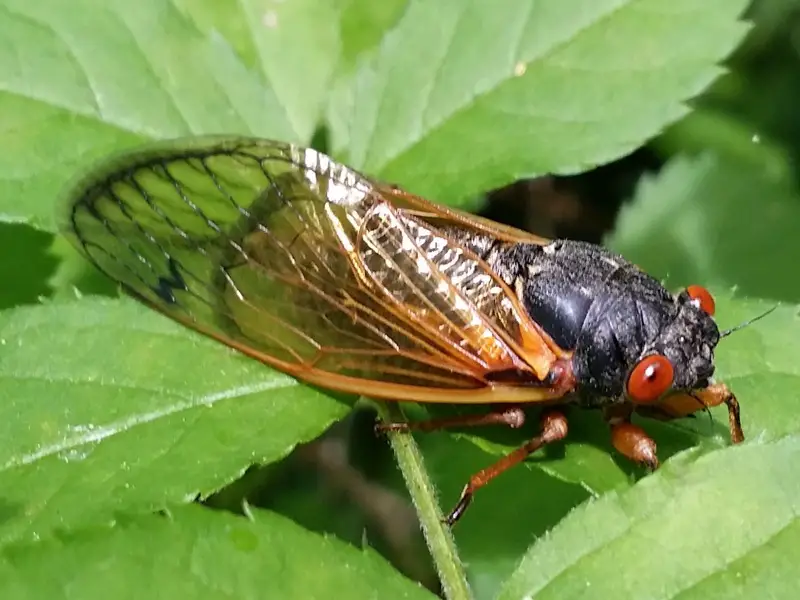
Magicicada tredecassini is a smaller 13-year cicada species that closely resembles its 17-year relative, Magicicada cassini. It has a shiny black body, bright red eyes, and orange-veined wings. Adults measure about 0.9 inches long, with a smooth, rounded abdomen lacking the orange bands found in other species.
Its call is a fast, pulsing buzz that rises and falls in a rhythmic pattern, sometimes described as a “tick-tick-tick” sound blended into a continuous drone. When thousands sing together, their synchronized calls create waves of sound that move through the forest canopy like a living echo.
This species inhabits deciduous woodlands, forest edges, and rural areas with mature hardwoods. Like all periodical cicadas, the nymphs spend most of their lives underground before emerging in massive numbers during their 13-year cycle. Adults are most active during warm, sunny days from late May to early July.
In North Carolina, Magicicada tredecassini is found primarily in the southeastern and central regions, often overlapping with Magicicada tredecim populations. During emergence years, they dominate forest soundscapes with their powerful, rhythmic buzzing.
13-year Cicada (Magicicada tredecula)
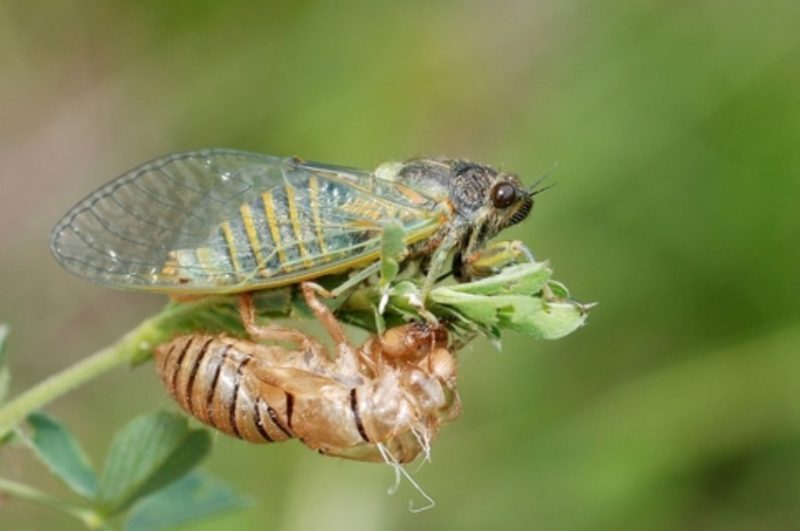
Magicicada tredecula is the smallest of the 13-year cicadas, measuring around 0.8 to 0.9 inches long. It has the typical black body and red eyes, but its wings are slightly shorter and more rounded compared to related species. The abdomen may have faint orange highlights, though it is often entirely black.
The call of Magicicada tredecula is a short, buzzing trill repeated at regular intervals. The song is softer and less continuous than that of the other 13-year cicadas, giving it a distinct cadence within the choruses of mixed broods. Males usually call from lower branches or shrubs.
This species prefers forested slopes, shaded woodlands, and streamside groves. It is most active during the late morning and early afternoon, emerging during warm, humid days in late spring. Adults live only a few weeks after emergence, devoting their brief lifespan to mating and reproduction.
In North Carolina, Magicicada tredecula is found mainly in the southern and central counties, often appearing alongside Magicicada tredecassini and Magicicada tredecim. Though smaller and quieter, it contributes to the remarkable symphony of sounds that accompany every 13-year cicada emergence in the state.
Tips for Observing and Listening to Cicadas in North Carolina
Learn Their Timing and Season
Cicadas in North Carolina are most active during the warmest months of the year—typically from late May through September. Annual species like Neotibicen appear every summer, while periodical species like Magicicada emerge only once every 13 or 17 years. Early morning and late afternoon are the best times to hear their songs, as males become most active during these hours.
Visit Forested and Shaded Areas
To experience cicadas up close, explore wooded regions, forest edges, and large city parks. Areas with mature oak, pine, or maple trees are ideal since cicadas depend on these trees for both feeding and breeding. In coastal regions, sandy pine forests and scrublands are especially good places to find unique species such as the Olympic Scrub Cicada (Diceroprocta olympusa).
Bring Binoculars and Audio Recorders
Cicadas often sing from high branches, making them difficult to spot with the naked eye. Binoculars help identify species by their coloration and wing patterns. If you’re a nature enthusiast, bring a recorder to capture the unique songs—each species has a distinct rhythm, pitch, and duration that can be recognized by sound alone.
Observe Responsibly
Avoid disturbing cicadas when they are calling or mating. These insects play an important ecological role by aerating soil and serving as food for birds and mammals. When periodical cicadas emerge in large numbers, resist the urge to remove them—they are harmless, short-lived, and essential to local ecosystems.
FAQs About Cicadas in North Carolina
What is the difference between annual and periodical cicadas?
Annual cicadas, such as Neotibicen canicularis or Neotibicen pruinosus, appear every summer and have overlapping life cycles, meaning some emerge each year. Periodical cicadas from the Magicicada genus emerge only once every 13 or 17 years in large synchronized broods.
Are cicadas dangerous to people or pets?
No. Cicadas do not bite, sting, or carry diseases. They are gentle insects that focus on reproduction during their short adult lives. Pets may occasionally eat cicadas, which is generally harmless, though large amounts can cause mild stomach upset.
Why are cicadas so loud?
Male cicadas produce sound using special structures called tymbals located on the sides of their abdomen. They contract their muscles to create vibrations that amplify through their hollow bodies. The volume of some species can reach 100 decibels, allowing them to attract females and compete with other males.
How long do cicadas live above ground?
Adult cicadas live only three to six weeks after emerging. During this time, they mate, lay eggs, and die shortly afterward. The nymphs that hatch from these eggs burrow underground and remain there for years before repeating the cycle.
Where in North Carolina can I see cicadas?
Cicadas are found statewide, from the mountain forests of western North Carolina to the sandy pine barrens of the Coastal Plain. Species diversity is highest in wooded and semi-rural areas where mature trees provide food and shelter. During emergence years, periodical cicadas are especially abundant in the western and Piedmont regions.
What should I do during a large emergence?
Enjoy it! Periodical cicada emergences are natural wonders that happen only a few times in a human lifetime. Avoid using pesticides—they are unnecessary and harmful to other wildlife. Instead, observe and document their songs, behaviors, and molted exoskeletons for a memorable wildlife experience.




